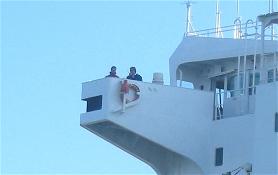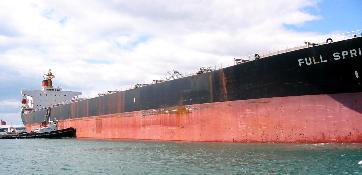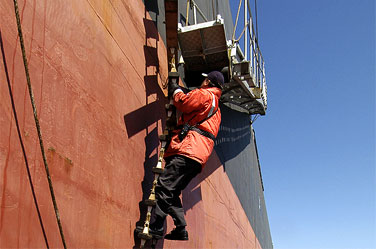What is pilotage
Pursuant to article 1 of the March 28th 1928 law, which still governs pilotage, "Pilotage consists in the assistance given to a captain by a personnel commissioned by the State for ship-manoeuvring into and out of harbours, and inside ports, roadsteads and maritime waters of rivers and channels."
Pilotage starts from the moment when the pilot turns up or gets onboard within the station limits, and ends up when the vessel arrives at her destination, at anchorage, in berth or at the limit of the station.
The pilot, who exercises a public service mission in a well-defined area, is granted a monopoly to carry out his duties. Beyond his advising role to the master, this veritable manoeuvring technician also bears the very important tasks to ensure navigation safety, to preserve the integrity of harbour works and to protect the environment in the vicinity and inside ports. The pilot is also an intermediary between the master and the various port protagonists during the entry and exit of vessels.
Pilotage as it is known today is governed by the March 28th 1928 law and the May 19th 1969 decree, revised in 1986 and in 2000.


Worldwide pilotage framework
Pilotage is organised in different ways throughout the world, but it is always subject to governmental control.
The maritime administration of the State is generally authorised to regulate pilotage services, to determine professional qualifications of pilots, to standardize training, to provide for compulsory pilotage and to arrange for investigations of incidents involving pilotage.
Compulsory pilotage is the primary mean of protecting private and public interests from the consequences of maritime casualties, while at the same time improving shipping efficiency.
Pilots may be employed by a port, an administration or by the State. Basically, most pilotage services are organised as independent economic entities. This system serves the best interests of all parties: the shipowner, the port, the pilots, and the State which ensures the environmental protection.
French pilotage framework
The State control
A pilotage station is a port service provider. Through the Minister of Transport, the State sets up the working management conditions of pilotage. He implements, withdraws or merges together the pilotage stations, fixes the number of pilots in each station, the limits of the compulsory pilotage area, the composition of the material necessary for pilotage services and the tariffs. Moreover, the State sets up equipment depreciation rules and specific accounting terms for the station management. He also authorizes investments and controls the financial results of each station.

The stations and their working staff
The authority of the Minister of Transport over the pilotage stations has been transferred to the Prefect of each region, who supervises pilotage matters in the region through the control exercised by the Regional Director of Maritime Affairs. It is the Prefect of the Region who fixes the local rules specific to each pilotage station, the Minister of Transport being responsible for pilotage at a national level, and particularly for the general regulation applicable to all pilotage stations.
The whole french pilotage organisation currently represents 32 pilotage stations (23 in France, 5 in the French overseas departments and 3 in the French overseas territories), with a total of 340 pilots, 277 seagoing personnel, 12 flying personnel and 112 administrative personnel.
Role, obligations and responsibilities
When the shipmaster calls upon him, the pilot is required to show up and to fulfil his request. He is also bound to serve the vessels in their appearance order, without favouritism. As soon as he is on the bridge, he provides to the master all the information and advices gotten from his specific knowledge of the area and his experience, until berth, anchorage or to the limit of the station. He has an overall appreciation of local regulations and unique conditions existing in the port area, which cannot be expected from a shipmaster.
Furthermore, he provides communication with port authorities, maritime traffic services, tugs and other ships. He is also required to report any depth variations, beacon modifications or casualties in relation to navigation safety. He has to warn the maritime security centres if he notices defects onboard (marine security, pollution prevention, working conditions). Finally, he has a duty to render assistance to vessels in distress, even if not required and as soon as they are in peril. The nature of the commission that he has been granted by the public powers and the constant State supervision on his activity led the Council of State to confer to the pilot the status of state agent, with all the constraint imposed by the commissioning system.
Career access
When recruitment is needed to fill a vacant pilot position or when the volume of ship traffic is increasing, a public exam is organized by the local Administration of Maritime Commerce. Pilot applicants must meet the following eligibility requirements :
- They should have navigated at least 72 months in the Merchant Marine or Navy, of which 48 months are spent as deck officer on ocean-going vessels, and they should hold a Captain’s degree
- They have to be at least 24 and not exceeding 35 years of age
- They have to meet the specific physical conditions set for pilots
The organization, steps and progression of the program for the pilot entrance exam is fixed by a Secretary of State decree. The exam consists in written tests (sea report, ship stability, tide problems, English language), oral tests (general knowledge on navigation, navigation and pilotage regulations, ship manoeuvring, pilotage) and assessment of the personal navigation record.
The new pilot must undergo a comprehensive training lasting several months by accompanying professional pilots, after which he will begin to progressively pilot vessels of larger sizes on his own. This process usually takes about five years to fully prepare a pilot to be entirely capable of manoeuvring all types of vessels.
To find out more, visit the féderation française des pilotes maritimes website.
Concerned with maintaining and constantly improving their knowledge, the pilots can complete their training using ship models such as the SOGREAH in Port Revel, or with the help of new generation electronic manoeuvring simulators such as the SPSA in Nantes.